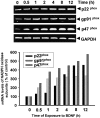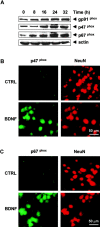Brain-derived neurotrophic factor can act as a pronecrotic factor through transcriptional and translational activation of NADPH oxidase
- PMID: 12460985
- PMCID: PMC2173377
- DOI: 10.1083/jcb.200112131
Brain-derived neurotrophic factor can act as a pronecrotic factor through transcriptional and translational activation of NADPH oxidase
Abstract
Several lines of evidence suggest that neurotrophins (NTs) potentiate or cause neuronal injury under various pathological conditions. Since NTs enhance survival and differentiation of cultured neurons in serum or defined media containing antioxidants, we set out experiments to delineate the patterns and underlying mechanisms of brain-derived neurotrophic factor (BDNF)-induced neuronal injury in mixed cortical cell cultures containing glia and neurons in serum-free media without antioxidants, where the three major routes of neuronal cell death, oxidative stress, excitotoxicity, and apoptosis, have been extensively studied. Rat cortical cell cultures, after prolonged exposure to NTs, underwent widespread neuronal necrosis. BDNF-induced neuronal necrosis was accompanied by reactive oxygen species (ROS) production and was dependent on the macromolecular synthesis. cDNA microarray analysis revealed that BDNF increased the expression of cytochrome b558, the plasma membrane-spanning subunit of NADPH oxidase. The expression and activation of NADPH oxidase were increased after exposure to BDNF. The selective inhibitors of NADPH oxidase prevented BDNF-induced ROS production and neuronal death without blocking antiapoptosis action of BDNF. The present study suggests that BDNF-induced expression and activation of NADPH oxidase cause oxidative neuronal necrosis and that the neurotrophic effects of NTs can be maximized under blockade of the pronecrotic action.
Figures







Similar articles
-
Thrombin-induced oxidative stress contributes to the death of hippocampal neurons: role of neuronal NADPH oxidase.J Neurosci Res. 2008 Apr;86(5):1053-63. doi: 10.1002/jnr.21571. J Neurosci Res. 2008. PMID: 18183616
-
Prothrombin kringle-2-induced oxidative stress contributes to the death of cortical neurons in vivo and in vitro: role of microglial NADPH oxidase.J Neuroimmunol. 2009 Sep 29;214(1-2):83-92. doi: 10.1016/j.jneuroim.2009.07.005. Epub 2009 Aug 5. J Neuroimmunol. 2009. PMID: 19660816
-
The role of NADPH oxidase, neuronal nitric oxide synthase and poly(ADP ribose) polymerase in oxidative neuronal death induced in cortical cultures by brain-derived neurotrophic factor and neurotrophin-4/5.J Neurochem. 2002 Aug;82(4):894-902. doi: 10.1046/j.1471-4159.2002.01040.x. J Neurochem. 2002. PMID: 12358795
-
Antiapoptotic and pronecrotic actions of neurotrophins.Antioxid Redox Signal. 2003 Oct;5(5):621-7. doi: 10.1089/152308603770310284. Antioxid Redox Signal. 2003. PMID: 14580318 Review.
-
More Insight into BDNF against Neurodegeneration: Anti-Apoptosis, Anti-Oxidation, and Suppression of Autophagy.Int J Mol Sci. 2017 Mar 3;18(3):545. doi: 10.3390/ijms18030545. Int J Mol Sci. 2017. PMID: 28273832 Free PMC article. Review.
Cited by
-
Dopamine promotes the survival of embryonic striatal cells: involvement of superoxide and endogenous NADPH oxidase.Neurochem Res. 2006 Apr;31(4):463-71. doi: 10.1007/s11064-006-9038-6. Epub 2006 May 9. Neurochem Res. 2006. PMID: 16758354
-
Persistent nuclear factor-kappa B activation in Ucp2-/- mice leads to enhanced nitric oxide and inflammatory cytokine production.J Biol Chem. 2005 May 13;280(19):19062-9. doi: 10.1074/jbc.M500566200. Epub 2005 Mar 9. J Biol Chem. 2005. PMID: 15757894 Free PMC article.
-
Modulatory Effect of Myokines on Reactive Oxygen Species in Ischemia/Reperfusion.Int J Mol Sci. 2020 Dec 9;21(24):9382. doi: 10.3390/ijms21249382. Int J Mol Sci. 2020. PMID: 33317180 Free PMC article. Review.
-
Stress increases vulnerability to inflammation in the rat prefrontal cortex.J Neurosci. 2006 May 24;26(21):5709-19. doi: 10.1523/JNEUROSCI.0802-06.2006. J Neurosci. 2006. PMID: 16723527 Free PMC article.
-
Brain-Derived Neurotrophic Factor Is Required for the Neuroprotective Effect of Mifepristone on Immature Purkinje Cells in Cerebellar Slice Culture.Int J Mol Sci. 2019 Jan 12;20(2):285. doi: 10.3390/ijms20020285. Int J Mol Sci. 2019. PMID: 30642045 Free PMC article.
References
-
- Alderson, R.F., A.L. Alterman, Y.A. Barde, and R.M. Lindsay. 1990. Brain-derived neurotrophic factor increases survival and differentiated functions of rat septal cholinergic neurons in culture. Neuron. 5:297–306. - PubMed
-
- Atwal, J.K., B. Massie, F.D. Miller, and D.R. Kaplan. 2000. The TrkB-Shc site signals neuronal survival and local axon growth via MEK and P13-kinase. Neuron. 27:265–277. - PubMed
-
- Bannister, J.V., P. Bellavite, A. Davoli, P.J. Thornalley, and F. Rossi. 1982. The generation of hydroxyl radicals following superoxide production by neutrophil NADPH oxidase. FEBS Lett. 150:300–302. - PubMed
-
- Barde, Y.A. 1994. Neurotrophins: a family of proteins supporting the survival of neurons. Prog. Clin. Biol. Res. 390:45–56. - PubMed
Publication types
MeSH terms
Substances
LinkOut - more resources
Full Text Sources
Other Literature Sources

